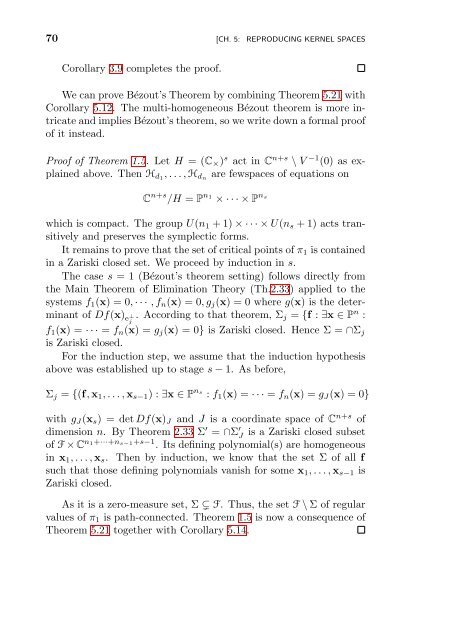Nonlinear Equations - UFRJ
Nonlinear Equations - UFRJ
Nonlinear Equations - UFRJ
Create successful ePaper yourself
Turn your PDF publications into a flip-book with our unique Google optimized e-Paper software.
70 [CH. 5: REPRODUCING KERNEL SPACES<br />
Corollary 3.9 completes the proof.<br />
We can prove Bézout’s Theorem by combining Theorem 5.21 with<br />
Corollary 5.12. The multi-homogeneous Bézout theorem is more intricate<br />
and implies Bézout’s theorem, so we write down a formal proof<br />
of it instead.<br />
Proof of Theorem 1.5. Let H = (C × ) s act in C n+s \ V −1 (0) as explained<br />
above. Then H d1 , . . . , H dn are fewspaces of equations on<br />
C n+s /H = P n1 × · · · × P ns<br />
which is compact. The group U(n 1 + 1) × · · · × U(n s + 1) acts transitively<br />
and preserves the symplectic forms.<br />
It remains to prove that the set of critical points of π 1 is contained<br />
in a Zariski closed set. We proceed by induction in s.<br />
The case s = 1 (Bézout’s theorem setting) follows directly from<br />
the Main Theorem of Elimination Theory (Th.2.33) applied to the<br />
systems f 1 (x) = 0, · · · , f n (x) = 0, g j (x) = 0 where g(x) is the determinant<br />
of Df(x) e ⊥<br />
j<br />
. According to that theorem, Σ j = {f : ∃x ∈ P n :<br />
f 1 (x) = · · · = f n (x) = g j (x) = 0} is Zariski closed. Hence Σ = ∩Σ j<br />
is Zariski closed.<br />
For the induction step, we assume that the induction hypothesis<br />
above was established up to stage s − 1. As before,<br />
Σ j = {(f, x 1 , . . . , x s−1 ) : ∃x ∈ P ns : f 1 (x) = · · · = f n (x) = g J (x) = 0}<br />
with g J (x s ) = det Df(x) J and J is a coordinate space of C n+s of<br />
dimension n. By Theorem 2.33 Σ ′ = ∩Σ ′ J is a Zariski closed subset<br />
of F × C n1+···+ns−1+s−1 . Its defining polynomial(s) are homogeneous<br />
in x 1 , . . . , x s . Then by induction, we know that the set Σ of all f<br />
such that those defining polynomials vanish for some x 1 , . . . , x s−1 is<br />
Zariski closed.<br />
As it is a zero-measure set, Σ F. Thus, the set F \ Σ of regular<br />
values of π 1 is path-connected. Theorem 1.5 is now a consequence of<br />
Theorem 5.21 together with Corollary 5.14.

















